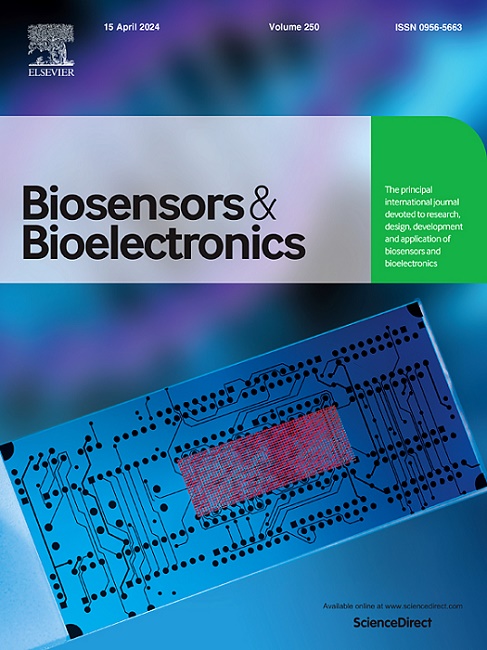In situ pH-Controlled electrochemical sensors for glucose and pH detection in calf saliva
IF 10.7
1区 生物学
Q1 BIOPHYSICS
引用次数: 0
Abstract
Electrochemical biosensors have been extensively researched and employed across diverse fields from environmental monitoring to clinical diagnostics. Detecting biomarkers like saliva pH and glucose are crucial indicators of the health and well-being of animals and opens the door for development of new non-invasive calf health measurements. Herein, we introduce a highly sensitive and stable electrochemical sensor for detection of pH and glucose in artificial and calf saliva. Pristine gold electrodes were employed for pH measurement using the voltage where the minimum of the gold oxide reduction peak occurred as a pH indicator. For glucose sensing, we utilized an effective in-situ pH control method enabled by interdigitated microelectrodes (IDEs) to optimize pH for accurate detection of glucose in artificial and calf saliva. Glucose oxidase (GOx) was first immobilized onto a platinum black modified gold IDE array through an electrodeposition process, which involved a mixture of o-phenylenediamine (o-PD) and β-cyclodextrin (β-CD). The enzymatic based glucose sensor showed an exceptional sensitivity of −0.46 nA mM−1 in artificial saliva at a wide range of concentrations from 0.02 mM to 7 mM, with a LOD of 0.3 μM. Simultaneously, a sensitivity of −166 mV.pH−1 was recorded for the pH sensor within the pH range of 5–9. These multiplexed sensors successfully detected glucose and pH levels in calf saliva noninvasively, which is particularly significant for meeting the frequent and continuous monitoring requirements of biomarkers (glucose, pH) associated with Bovine respiratory disease (BRD) and diarrhoetic calves.
求助全文
约1分钟内获得全文
求助全文
来源期刊

Biosensors and Bioelectronics
工程技术-电化学
CiteScore
20.80
自引率
7.10%
发文量
1006
审稿时长
29 days
期刊介绍:
Biosensors & Bioelectronics, along with its open access companion journal Biosensors & Bioelectronics: X, is the leading international publication in the field of biosensors and bioelectronics. It covers research, design, development, and application of biosensors, which are analytical devices incorporating biological materials with physicochemical transducers. These devices, including sensors, DNA chips, electronic noses, and lab-on-a-chip, produce digital signals proportional to specific analytes. Examples include immunosensors and enzyme-based biosensors, applied in various fields such as medicine, environmental monitoring, and food industry. The journal also focuses on molecular and supramolecular structures for enhancing device performance.
 求助内容:
求助内容: 应助结果提醒方式:
应助结果提醒方式:


